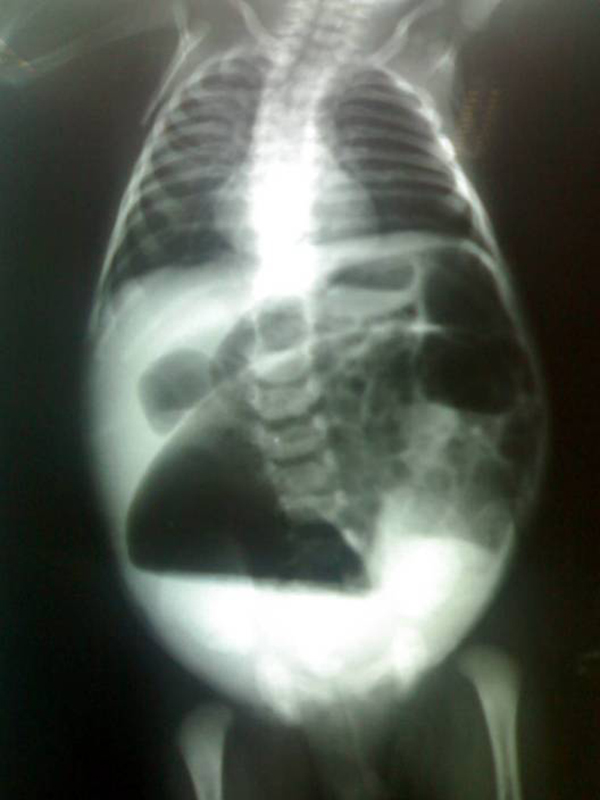Playlist
Show Playlist
Hide Playlist
Necrotizing Enterocolitis: Diagnosis and Management
-
Slides NecrotizingEnterocolitis Surgery.pdf
-
Download Lecture Overview
00:01
Here's an abdominal x-ray.
00:03
In this x-ray,
the baby is lying supine on the back.
00:07
Note the distended loops of intestines.
00:11
Here's another view.
00:13
This is what we call
commonly a babygram.
00:16
You see the entire
baby on the x-ray.
00:18
And again, note,
there are multiple
loops of dilated bowel.
00:22
How do we manage
these patients with
NEC (or necrotizing enterocolitis)?
Initially, it's mostly medical.
00:29
If this is bottle-feed
or feeds, in general, induced,
we discontinue feeds
and make the patient
NPO (nothing by mouth).
00:38
Sometimes, the baby requires
NG tube and bowel rest.
00:43
We initiate broad-spectrum antibiotics,
covering broadly for gram-negative rods
and anaerobic organisms.
00:52
And because the nutrition to
the baby is of utmost importance
and we can't right
away use the bowel,
you should consider
TPN on these patients.
01:04
However, if the patient is clinically deteriorating,
has hemodynamic instability,
those are indications for surgery.
01:14
Pneumoperitoneum suggests that there
was a perforation or ischemic bowel.
01:19
Any pneumoperitoneum
requires exploratory laparotomy.
01:24
And as I mentioned,
if the baby has progressive clinical deterioration,
as evidenced by septic shock or hypotension,
that may also warrant surgery.
01:35
Now, if you're presented with this scenario,
again, pneumoperitoneum,
signs of perforation
or progressive clinical deterioration,
the next step of management should be
should be surgery.
01:49
I’d like to pose a question to you.
01:51
What if your patient
has continued hypotension
and is progressively lethargic?
What would you do?
I’ll give you a second
to think about this.
02:02
That's right.
02:03
Absolutely take the patient
to the operating room.
02:05
Don't stop at radiology.
02:07
Don't get any workup.
02:08
These patients require
exploratory laparotomy.
02:15
Now, let's review some very
important clinical pearls
and high-yield information
for your examination.
02:20
Remember, you need to have
a high index of suspicion
if your newborn is not tolerating feeds
and has clinical deterioration.
02:28
Don't wait for late signs
such as septic shock
or abdominal wall erythema
to diagnose necrotizing enterocolitis.
02:37
For your examination,
remember that the next step
of management is not surgery.
02:43
It's usually to start with medical
management and supportive care.
02:47
However,
as a reminder,
if the scenario changes
and the patient has clinical deterioration,
or you suspect that there's ischemic bowel,
by all means,
take the patient to the operating room
for an exploratory laparotomy.
03:02
Thank you very much
for joining me on this discussion
of necrotizing enterocolitis.
About the Lecture
The lecture Necrotizing Enterocolitis: Diagnosis and Management by Kevin Pei, MD is from the course Special Surgery.
Included Quiz Questions
Which of the following is an indication for surgical intervention in patients with necrotizing enterocolitis?
- Pneumoperitoneum detected by abdominal imaging
- Preterm infants with a gestational age <32 weeks
- Dilated loops of bowel detected by abdominal imaging
- Laboratory evaluation showing thrombocytosis and eosinophilia
- Patients who cannot tolerate oral intake
Which of the following is not a part of the medical management of a patient with necrotizing enterocolitis?
- Intravenous corticosteroids
- Broad-spectrum antibiotics
- Bowel rest
- Fluid replacement
- Total parenteral nutrition
Customer reviews
5,0 of 5 stars
| 5 Stars |
|
5 |
| 4 Stars |
|
0 |
| 3 Stars |
|
0 |
| 2 Stars |
|
0 |
| 1 Star |
|
0 |




